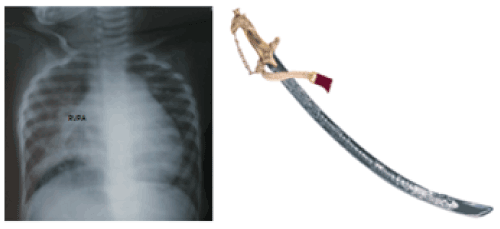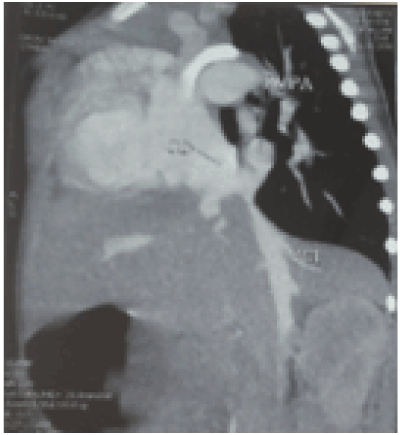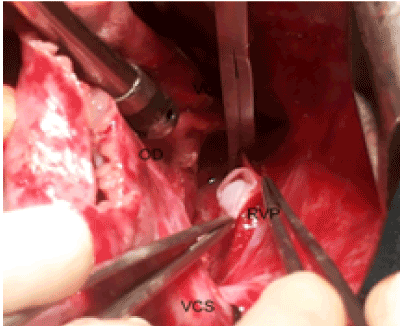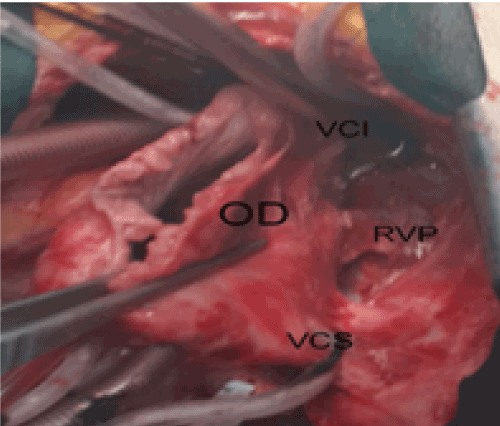Abstract
Introduction:The Scimitar syndrome is a rare congenital heart disease characterized by partial or total anomalous pulmonary venous return, located mostly in the lower vena cava. It needs to be diagnosed early and taken care in time. Surgical repair is indicated in symptomatic patients, with often good results.
Presentation of case:We report a case of scimitar syndrome associated with major pulmonary hypertension in a two-year-old child.The surgical procedure consisted in a disconnection of the right pulmonary venous collector and its reimplantation in theleft atrium followed by the closure of a high interatrial communication by a heterologous pericardium patch.
Discussion:In addition to medical treatment, several surgical tactics can be considered as the reimplantation of the abnormal pulmonary vein into the left atrium. Other options are described as the tunneling of APVR to the left atrium, percutaneous embolization, under radiological control.
Conclusion: The scimitar syndrome is a rare congenital anomaly that needed to be diagnosed early and taken care of in time. Surgical repair is indicated in symptomatic patients, with often good results.
Keywords
scimitar syndrome; surgery; pulmonary hypertension
Introduction
The Scimitar syndrome or veno-lobar syndrome [1] is a rare congenital heart disease characterized by partial or total anomalous pulmonary venous return, located mostly in the lower vena cava, with or without hypoplasia or pulmonary right sequestration. In this observation, we are interested in the surgical management of scimitar syndrome in a two-year-old child.
Case report
We report a case of a two years old child suffering since the age of 3 months from permanent lung infections with cyanosis. In the exam; we found an eutrophic baby, polypneic in 30 cycles / min, tachycardia at 120 bpm. The auscultation revealed a systolic murmur with a pulmonary B2 glow.The Chest X-ray(Figure 1) shows a cardiac dextro-position and a linear opacity to the right of the atrium. The diagnosis of scimitar syndrome was admitted after an echocardiography showing a low sinus venosus Interatrial communication next to the anastomosis of the inferior vena cava (IVC) with an exclusive Left-Right shunt, a substantial dilation of the right atrium and right ventricle and a right anomalous pulmonary venous return (APVR) entering a dilated inferior vena cava; associated with major pulmonary hypertension to 75 mm Hg. The angiography revealed a partial APVR all the infra-heart right lung in the inferior vena cava (Figure 2). The patient was operated under cardiopulmonary bypass and cardiac arrest. The surgical procedure consisted in a disconnection of the right pulmonary venous collector (Figure 3) and its re-implantation in theleft atrium (Figure 4) followed by the closure of a high IAC by a heterologous pericardium patch. The output of CEC was simple with 0.05 gamma / kg/ min of adrenaline and 0.4 gamma / kg /m of corotrope. The operating result was favorable with an extubation at the second day and gradual degression of vasoactive drugs. Postoperatively, the patient did well.The postoperative Trans-thoracic echocardiogram revealed no anomalous pulmonary arterial supply and left PV drainage.

Figure 1. The Chest X-ray: linear opacity to the right of the atrium as a Turkish saber.

Figure 2. The angiography: aright anomalous pulmonary venous return (APVR) entering a dilated inferior vena cava.

Figure 3. A disconnection of the right pulmonary venous collector.

Figure 4. Re-implantation of the right pulmonary venous collector in the left atrium.
Discussion
The scimitar syndrome is a rare heart defect (one to three per 100,000 births) [2]. It consists in a partial APVR straight to the inferior vena cava [1] with as a further consequence a right lung hypoplasia. The term "scimitar syndrome" is derived from the resemblance of the radiological right APVR to a Turkish saber (Figure1). In its full form, it combines: a heart dextroposition, a small right lung and bronchopulmonary sequestration lung [2].
The discovery of the disease occurs at age of 55 days [3] with prominent respiratory symptoms (tachypnea, cyanosis, permanent pulmonary infection...) [2].
The genetic factor has been suspected in front ofthe association of dysmorphic features, craniofacial, central nervous system anomalies, and renal agenesis [4, 5]. Furthermore, Najmet al.[6] reported also an association with Turner syndrome and Vater's syndrome.
The pulmonary hypertension in the scimitar syndrome is responsible for almost all of the symptoms. It is because of a stenosis or a large flow of APVR, a systemic arterial substitute for the right lung and a reduction of the right pulmonary vascularization.
Surgery is reserved for patients with severe symptoms related to lung sequestration, recurrent pneumonia or significant left-right shunt with pulmonary hypertension, especially when combined with IAC [2]. In addition to medical treatment, several surgical tactics can be considered as the reimplantation of the abnormal pulmonary vein into the left atrium [2]. Other options are described as the tunneling of APVR to the left atrium, percutaneous embolization, under radiological control [2]. In our patient, we have advocated the introduction of the APVR in the OG due to its association with a high IAC making its tunneling in the left atrium complicated. All these techniques are still controversial, and a few therapeutic recommendations are being proposed.
Conclusion
The scimitar syndrome is a rare congenital anomaly that needed to be diagnosed early and taken care of in time. Surgical repair is indicated in symptomatic patients, with often good results.
References
- Martinez SC, Eghtesady P, Bhalla S, Ludbrook PA (2015) Scimitar Syndrome: Multimodal Imaging Before and After Repair. Tex Heart Inst JDec 42: 593–595. [Crossref]
- Alberti N, Espérabe F(2011)Découvertefortuite d’un syndrome du cimeterre au coursd’unevisitesystématique : à propos d’un cas. Médecine et armées40:111-114.
- Al Rukban H, Al Ghaihab M, Tamimi O, Al-Saleh S(2014) Clinical spectrum of infantile scimitar syndrome: A tertiary center experience. Ann PediatrCardiol7: 29–33. [Crossref]
- Ruggieri M, Abbate M, Parano E, Distefano A, Guarnera S, et al. (2003) Scimitar vein anomaly with multiple cardiac malformations, craniofacial, and central nervous system abnormalities in a brother and sister: familial scimitar anomaly or new syndrome? Am J Med Genet A 116A: 170-175.[Crossref]
- Kahraman H1, Ozkan F, Alt?noluk B, Koksal N (2012) Scimitar syndrome with renal agenesis. N Am J Med Sci4:193–195.[Crossref]
- Uthaman B, Abushaban L, Al-Qbandi M, Rathinasamy J (2008) The impact of interruption of anomalous systemic arterial supply on scimitar syndrome presenting during infancy. Catheter Cardiovasc Interv71:671–678. [Crossref]




